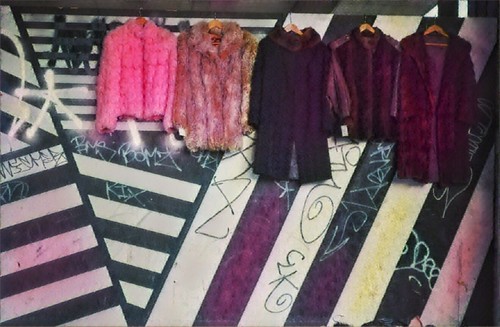The purchase Eleutheroside E upregulation of sno-miRNA-28 and SNHG1 in tumours and its romantic relationship to p53 parallels our knowing of other miRNA regulatory loops that closely interact with the p53 pathway and perform considerable roles in p53-mediated apoptosis and cell cycle arrest. For instance, the miR-34 loved ones mediates tumour suppression by way of a good comments loop involving p53 and MDM4 [62] 15 miRNAs, which includes the miR-106b/ninety  three/twenty five cluster, miR-17-92 cluster and the miR-106a-92 cluster, are repressed by p53 and involved with E2F in a feed-forward loop selling proliferation [63] while miR-192, 194 and 215 are concerned in the p53-MDM2 car-regulatory loop [sixty four]. Whilst our analysis has unveiled nevertheless one more feed-ahead loop involving p53 and a miRNA, it is shocking that this regulatory loop is based mostly on a snoRNA-derived miRNA, thereby constructing on the novel regulatory roles of snoRNAs in cancer. Collectively, this study builds on a modest but increasing information foundation of small RNAs from “unfamiliar” sources actively playing crucial organic roles. We imagine a lot more novel targets of sno-miR-28 will be discovered, and functions for much more miRNAs derived from novel resources will be explored. From this point of see, developments of understanding in most cancers regulatory networks and their conversation with modest non-coding RNAs could eventually provide insights into new methods to most cancers remedy.
three/twenty five cluster, miR-17-92 cluster and the miR-106a-92 cluster, are repressed by p53 and involved with E2F in a feed-forward loop selling proliferation [63] while miR-192, 194 and 215 are concerned in the p53-MDM2 car-regulatory loop [sixty four]. Whilst our analysis has unveiled nevertheless one more feed-ahead loop involving p53 and a miRNA, it is shocking that this regulatory loop is based mostly on a snoRNA-derived miRNA, thereby constructing on the novel regulatory roles of snoRNAs in cancer. Collectively, this study builds on a modest but increasing information foundation of small RNAs from “unfamiliar” sources actively playing crucial organic roles. We imagine a lot more novel targets of sno-miR-28 will be discovered, and functions for much more miRNAs derived from novel resources will be explored. From this point of see, developments of understanding in most cancers regulatory networks and their conversation with modest non-coding RNAs could eventually provide insights into new methods to most cancers remedy.
MDA-MB-231 cells have been suspended in cold PBS by scraping cross-connected at 254 nM making use of a Stratalinker. Mobile pellets ended up lysed (.one% SDS, .five% deoxycholate, .5% NP-40 with protease inhibitors, Roche, Indianapolis, IN United states of america) for 10 mins on ice adopted by RQ1 DNAse (Promega, Madison, WI Usa) at 37 for fifteen mins with shaking. RNAse A/T1 (Ambion, Grand Island, NY United states) was then added for eight minutes, prior to the addition of EDTA (thirty mM). Pellets have been then spun (30,000 rpm) and the lysate subjected to immunoprecipitation for two h with a pan-anti-Ago antibody (2A8) conjugated to protein-A dynabeads (Invitrogen, Grand Island, NY United states of america) using bridging rabbit anti-mouse IgG (Jackson ImmunoResearch Laboratories, West Grove, PA Usa). Pellets were then successively washed (.1% SDS, .five% deoxycholate, .five% NP40 in 1 PBS .1% SDS, .5% deoxycholate, .five% NP40 in five PBS 50 mM Tris pH 7.five, ten mM MgCl2, .5% NP40) and on-bead phosphatase remedy carried out for thirty minutes with antarctic phosphatase (New England Biolabs, NEB, Ipswich, MA United states of america) in the existence of superasin RNAse inhibitor (Ambion). The 3′ RNA linker (CAGACGACGAGCGGG) was labeled with P32 employing T4-PNK (NEB) and ligated on-bead for one h at sixteen with T4 RNA ligase (Fermentas, Thermo Fisher Scientific, Pittsburgh, PA United states of america). Beads were then washed as earlier and taken care of with PNK to ligate the 5′ RNA linker (AGGGAGGACGAUGCGGxxxG, with “X” symbolizing diverse nucleotides for barcoding). Beads ended up resuspended in four LDS Novex loading buffer with 4% B-mercaptoethanol, incubated at 70 for ten mins and the19649632 supernatant loaded on Novex NuPAGE 42% Bis-Tris acrylamide gels (Bio-Rad, Hercules, CA United states of america). Right after running, the Back-RNA complexes ended up then transferred to nitrocellulose and exposed to film at -eighty for three times. Complexes working at ~110 kDa had been then excized with a scalpel and resuspended (one hundred mM Tris pH 7.5, 50 mM NaCl, ten mM EDTA, four mg/ml proteinase K) for 20 min at 37. The sample was incubated for an added twenty minutes in the existence of 3.5 M urea and RNA isolated by a phenol-chloroform extraction. Samples had been then run on a 10% denaturing (1:19) polyacrylamide gel and exposed to movie with an intensifying monitor at -eighty for 5 days. A slim band corresponding to the Ago-miRNA (~a hundred and ten kD) was excized, crushed and eluted at 37 for 1 h (1M NaOAc, pH five.2, 1 mM EDTA). RNA was precipitated right away with ethanol, centrifuged and dried, and then resuspended in eight l H2O.
